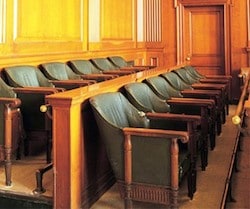Plaintiffs (a mother and her minor child) resided in a home that was owned by Defendant in Baltimore, Maryland. Plaintiffs alleged that the home had chipping, peeling and flaking lead paint and that as a result of the minor child’s exposure to that lead paint, the child suffered a brain injury.
According to the complaint, the minor child ate chips of the lead-based paint and became “seriously, painfully and permanently injured, ill and [infirm] in head, body, and limbs . . . .”
The Circuit Court for Baltimore City, however, granted summary judgment for the Defendant because no evidence was proffered that proved that any paint on the property contained lead.
- What is the settlement value of a lead paint case in Baltimore City?
- Learn about the history and real-life practicalities of handling a lead case in Baltimore City

Plaintiffs’ lawyers argued on appeal that the trial court erred in granting defendant’s motion for judgment because the record contained circumstantial evidence from which a trier of fact could infer the presence of lead-based paint. The Maryland Court of Special Appeals found that the defendant’s claim was based on the fact that there was no evidence that the paint in the dwelling was lead-based paint. There was, however, sufficient circumstantial evidence presented by plaintiffs that generated a genuine dispute as to material. Inferring all facts most favorably to the Plaintiffs, the evidence established that the chipping and peeling paint inside the apartment was the only real source of the minor child’s lead poisoning.
The court found that this inference for the Plaintiffs, coupled with the well-known fact that homes built before 1950 often contained lead-based paint, could indeed support an inference that the paint in question contained lead. Accordingly, under the circumstances, the appellate court concluded the trial court erred in granting the motion for summary judgment.
Quick Analysis
This case underscores the burden of proof that a plaintiff is required to meet to bring a claim. In any personal injury claim in Maryland, be it for an auto accident, medical negligence, or any other claim of personal injury as a result of the mistake of another, your lawyer must prove four elements: (1) the existence of a legal duty to conform to a reasonable standard of conduct. In other words, there was a legal duty for the defendant to act (or not to act); (2) The defendant failed to perform the standard of conduct set forth in the first element; (3) the defendant’s failure to act in the standard was the proximate cause of plaintiff’s injury; and (4) actual damages or injury resulted from the negligence.
Let’s apply this to a simple rear-end auto accident case in Maryland. A driver, insured by GEICO, hits you from behind while you are waiting at a traffic light. There is a duty for the GEICO driver to reduce your speed to avoid an accident with the car in front of him/her (Element 1.) See Transportation Article Section 21-801(b) Driver to Control Speed. The GEICO driver breached the duty of care when he/she fails to reduce his/her speed to avoid the auto accident (Element 2). The GEICO driver’s failure to reduce his/her speed causes you personal injury (Element 3). Finally, the auto accident leaves you with a herniated lumbar disc, a fractured wrist and $50,000 in medical bills that are causally related to the accident (Element 4). If your case does not settle and you are required to go to trial and your attorney proves these elements, GEICO would be required to pay your medical bills (even if your health insurance paid your bills), lost wages, and pain and suffering that was related to the auto accident.
Of course, these four elements often become the hotly contested issues in any personal injury/auto accident case. Any skillful defense attorney will contest Elements 1 and 2, breach of duty, by claiming that the injured party also breached a duty that he or she had and somehow contributed to the accident (a sudden stop that causes a rear-end accident).
And, of course, Element 4 is contested in almost every auto accident case. The opposing attorney will almost always take the position that either the plaintiff did not sustain a personal injury in the auto accident, or, the injuries sustained were from another accident or incident before or after the car accident
More Information
- Maryland Law Update: latest Maryland law updates
- Assistance for Maryland Lawyers: templates for everything you want to put together a tort claim
- Lead Paint Claims: answers to question commonly asked by victims and lawyers in Baltimore City
 Plaintiff Attorney Legal Information Center
Plaintiff Attorney Legal Information Center